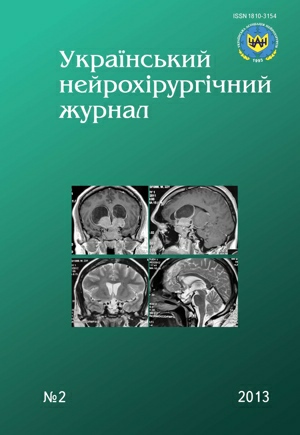Observation of successful treatment of acute subdural hematoma in the posterior cranial fossa due to penetrating eye injury
DOI:
https://doi.org/10.25305/unj.51881Keywords:
cranio-orbital injury, penetrating eye injury, acute subdural hematoma, cerebellar hemisphere, posterior cranial fossaAbstract
The observation of penetrating cranio-orbital injury by sharp object at fall from a high is presented. The foreign object passed along the right orbit medial wall and penetrated to the middle cranial fossa through the upper palpebral fissure. Further promotion of the object arose damage of cerebellar structures and tentorium with focal intracerebral lesions and acute subdural hematoma of the posterior cranial fossa.
Clinically, the eye injury manifested by paraorbital hematoma, subconjuctival hemorrhage, fixed mydriasis, exophthalmos, and total right ophthalmoplegia, compression of the cerebellum — by the subdural hematoma and progressive consciousness impairment. The wound channel direction was visualized on MRI (with serial sections 1 mm) in subacute period.
Right occipital bone resectional craniotomy was performed, Torkildsen ventriculo-cisternal shunt was placed, subdural hematoma was removed totally. The patient was discharged with improvement. According to a 6-month dynamic observation, there were no pyo-inflammatory complications.
References
1. Mandat TS, Honey CR, Peters DA, Sharma BR. Artistic assault: an unusual penetrating head injury reported as a trivial facial trauma. Acta Neurochir (Wien). 2005 Mar;147(3):331-3; discussion 332-3. [PubMed] [CrossRef]
2. Paiva WS, Monaco B, Prudente M, Soares MS, de Amorim RL, de Andrade AF, Teixeira MJ. Surgical treatment of a transorbital penetrating brain injury. Clin Ophthalmol. 2010 Oct 5;4:1103-5. [PubMed] [CrossRef]
3. Paiva WS, Saad F, Carvalhal ES, De Amorim RL, Figuereido EG, Teeixera MJ. Transorbital stab penetrating brain injury. Report of a case. Ann Ital Chir. 2009 Nov-Dec;80(6):463-5. [PubMed]
4. Domenicucci M, Qasho R, Ciappetta P, Vangelista T, Delfini R. Surgical treatment of penetrating orbito-cranial injuries. Case report. J Neurosurg Sci. 1999 Sep;43(3):229-34. [PubMed]
5. Agrawal A, Pratap A, Agrawal CS, Kumar A, Rupakheti S. Transorbital orbitocranial penetrating injury due to bicycle brake handle in a child. Pediatr Neurosurg. 2007;43(6):498-500. [PubMed] [CrossRef]
6. Lin HL, Lee HC, Cho DY. Management of transorbital brain injury. J Chin Med Assoc. 2007 Jan;70(1):36-8. [PubMed] [CrossRef]
7. Matsuyama T, Okuchi K, Nogami K, Hata M, Murao Y. Transorbital penetrating injury by a chopstick--case report. Neurol Med Chir (Tokyo). 2001 Jul;41(7):345-8. [PubMed] [CrossRef]
8. Huiszoon WB, Noë PN, Manten A. Fatal transorbital penetrating intracranial injury caused by a bicycle hand brake. Int J Emerg Med. 2012 Sep 18;5(1):34. [PubMed] [CrossRef]
9. Ahmad FU, Suri A, Mahapatra AK. Fatal penetrating brainstem injury caused by bicycle brake handle. Pediatr Neurosurg. 2005 Jul-Aug;41(4):226-8. [PubMed] [CrossRef]
10. Gopalakrishnan M, Indira Devi B. Fatal penetrating orbitocerebral injury by bicycle brake handle. The Indian Journal of Neurotrauma. 2007 Dec;4(2):123–4" target="_blank">[PubMed] [CrossRef]
11. Chattopadhyay S, Sukul B, Das SK. Fatal transorbital head injury by bicycle brake handle. J Forensic Leg Med. 2009 Aug;16(6):352-3. [PubMed] [CrossRef]
12. Turbin RE, Maxwell DN, Langer PD, Frohman LP, Hubbi B, Wolansky L, Mori M. Patterns of transorbital intracranial injury: a review and comparison of occult and non-occult cases. Surv Ophthalmol. 2006 Sep-Oct;51(5):449-60. [PubMed] [CrossRef]
Downloads
Published
How to Cite
Issue
Section
License
Copyright (c) 2013 Andriy Sirko, Vadym Botikov

This work is licensed under a Creative Commons Attribution 4.0 International License.
Ukrainian Neurosurgical Journal abides by the CREATIVE COMMONS copyright rights and permissions for open access journals.
Authors, who are published in this Journal, agree to the following conditions:
1. The authors reserve the right to authorship of the work and pass the first publication right of this work to the Journal under the terms of Creative Commons Attribution License, which allows others to freely distribute the published research with the obligatory reference to the authors of the original work and the first publication of the work in this Journal.
2. The authors have the right to conclude separate supplement agreements that relate to non-exclusive work distribution in the form of which it has been published by the Journal (for example, to upload the work to the online storage of the Journal or publish it as part of a monograph), provided that the reference to the first publication of the work in this Journal is included.









